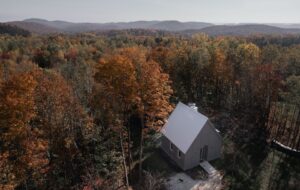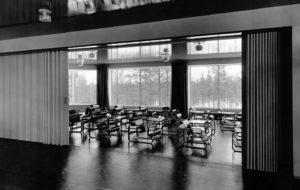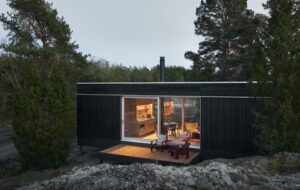 Balfron Tower’s arrow-slit windows. Photo: WandererWandering via Flickr (cropped)
Balfron Tower’s arrow-slit windows. Photo: WandererWandering via Flickr (cropped)
Ernö Goldfinger’s original interiors for this distinctive east London block, like its social tenants, are being replaced, leaving just the shell of a utopian vision, writes Jessica Mairs
Emerging from the mouth of the Blackwall Tunnel in Poplar, east London, traffic is propelled past the dystopian scene of the Smithsons’ half-demolished Robin Hood Gardens estate and onto the tangle of lanes shadowed by the bush-hammered concrete form of Balfron Tower.
Arrow-slit windows, a drawbridge-like approach and an arrangement of chimneys protruding from the roof-like turrets lend the tower the appearance of a fortress on the edge of the A12 – albeit one currently sheathed in the monogrammed plastic sheeting of its redeveloper.
Ernö Goldfinger, the building’s Hungarian-born architect, expressed his socialist post-war ideals in the 27-storey tower that was built between 1965 and 1967 in this experimental corner of east London. Corbusian streets in the sky saw tenants of terraced houses rehomed as communities along aerial walkways that replicated the pavements outside their former homes.
Less goodwill has been afforded to today’s social tenants, who were moved out of Balfron ahead of its present refurbishment, without the right to return. The transfer of the grade II*-listed social housing block into private hands has been well documented, though perhaps not as vehemently opposed or widely publicised as one would expect.
Goldfinger and his wife Ursula famously took up residence in a flat on the top floor of the tower when it opened in 1968, attracting plenty of (mixed) publicity. They spent almost three months observing what residents made of the design and compiled a snagging list that would go on to inform tweaks to the design of its west London sibling, Trellick Tower. Excerpts from Ursula’s diary noted day-to-day grievances such as heavy doors, whistling vents and gusty terraces, which would be rectified at Trellick.
Balfron’s distinctive silhouette – created by the spindly detached service tower and the skybridges that link it to the main bulk of the block at every third floor – has been largely overshadowed by the fame of its almost identikit younger sibling. Little plaster-cast homages to this later brutalist icon located on the edge of the more affluent Notting Hill area can be purchased as home ornaments for £150, but there has been less sentimentality for the earlier building.
Just over 50 years on from Balfron’s completion, both towers demand significant repairs. Restoration of the concrete exterior and much-needed renovations to kitchens and bathrooms were at the end of the stick dangled in front of tenants when they voted in favour of signing Balfron over to the housing association Poplar HARCA for regeneration in 2008.
But, when the housing association said it was unable to stump up the undisclosed cost of the refurbishment, it teamed up with Londonewcastle and United House Developments to sell flats on the market to fund the works. Former tenants were shifted to other properties on the Brownfield Estate or relocated further afield. The charity Bow Arts Trust replaced them with ‘artist-residents’ – though only temporarily – amid claims the building was being ‘art-washed’ or socially cleansed.
Renovation works being carried out by Studio Egret West and Ab Rogers Design seek to redress past aesthetic ills – removing plastic windows, for example – as well as adding communal spaces like a cinema, shared dining room and playroom in the service tower (Goldfinger’s original plans called for a jazz-slash-pop room for teenagers and play areas for children).
But the regeneration will also see the majority of Balfron’s original interiors swept away and replaced with more fashionable open-plan living areas. Just one of each of the original six flat types will be retained on the request of listing body Historic England, leaving a shell of Goldfinger’s utopian vision, a kind of public housing facadism for the private sector and, in this sense, an icon lost.
Renovation works on the blocks are concurrent, with Trellick Tower also undergoing repair works at a cost of £7.2 million to fix its ageing concrete exterior and replace windows. Both towers suffered the usual tale of degradation often attached to Britain’s post-war public housing, but mixed tenancy appears to have been the success story of Trellick. Managed by Kensington and Chelsea council, just 37 out of the 217 flats there are privately owned. One duplex currently on the market for just under £800,000 makes the owners liable to pay a fee of £40,000 on completion of the works: an example of what could have been at Balfron.


















